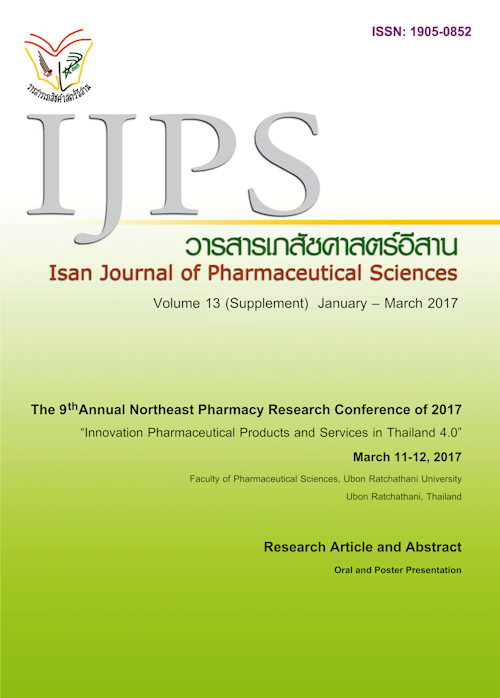Development of Theophylline Orodispersible Film Fabricated by 2D Printing Technique
Main Article Content
Abstract
Introduction: Medicine printing is one of the technologies which has been applied to prepare the pharmaceutical product. This precise technology can scale the size of medicine. Therefore, researchers are interested in this technology to develop the orodispersible film. Methods: In this study, seed gum from Tamarindus Indica Linn was selected to use as film former and sorbitol was used for plasticizing purpose. Theophylline was chosen as a printed model drug. Results: The results of the film mechanical properties indicated that increasing of sorbitol enhanced film flexibility. On the other hand, increasing gum portion leaded to tough and stress film. The proper amount of gum and sorbitol to prepare film is 3.5 % w/w gum and 97:3 sorbitol. The FTIR result revealed that there was no interaction between theophylline and gum after printing process. Drug loading study expressed that printing technology is very precise since the loaded drug on films accurately increased when the drug printing was repeated. Moreover, the in vitro drug release from the drug printed film reached 80% of total drug release within 3 minutes. Conclusion: These results showed that the gum from tamarind seed shine possibility of the gum film application to be potential printing substrate for the 2D printing technology.
Article Details
In the case that some parts are used by others The author must Confirm that obtaining permission to use some of the original authors. And must attach evidence That the permission has been included
References
Buanz A. B., Saunders M. H., Basit A. W., et al. (2011). Preparation of personalized-dose salbutamol sulphate oral films with thermal ink-jet printing. Pharm Res 2011; 28(10): 2386-2392.
ElMeshad A. N. and El Hagrasy A. S. Characterization and optimization of orodispersible mosapride film formulations. AAPS Pharm Sci Tech 2011; 12(4): 1384-1392.
Genina N., Fors D., Vakili H., at al. Tailoring controlled-release oral dosage forms by combining inkjet and flexographic printing techniques. Eu J Pharm Sci 2012:47(3): 615-623.
Patrick Cooley D. and Bogdan Antohe W. Applications of Ink-Jet Printing Technology to BioMEMS and Microfluidic Systems. SPIE Conf Micro Bio MEMS 2001: 1-11.
Planchette C. , Pichler H. , Wimmer-Teubenbacher M., et al. Printing medicines as orodispersible dosage forms: Effect of substrate on the printed micro-structure. Int J Pharm 2016; 509(1p2): 518-527.
Sandler N., Maattanen A., Ihalainen P., et al. Inkjet printing of drug substances and use of porous substrates-towards individualized dosing. J Pharm Sci 2011; 100(8): 3386-3395.


